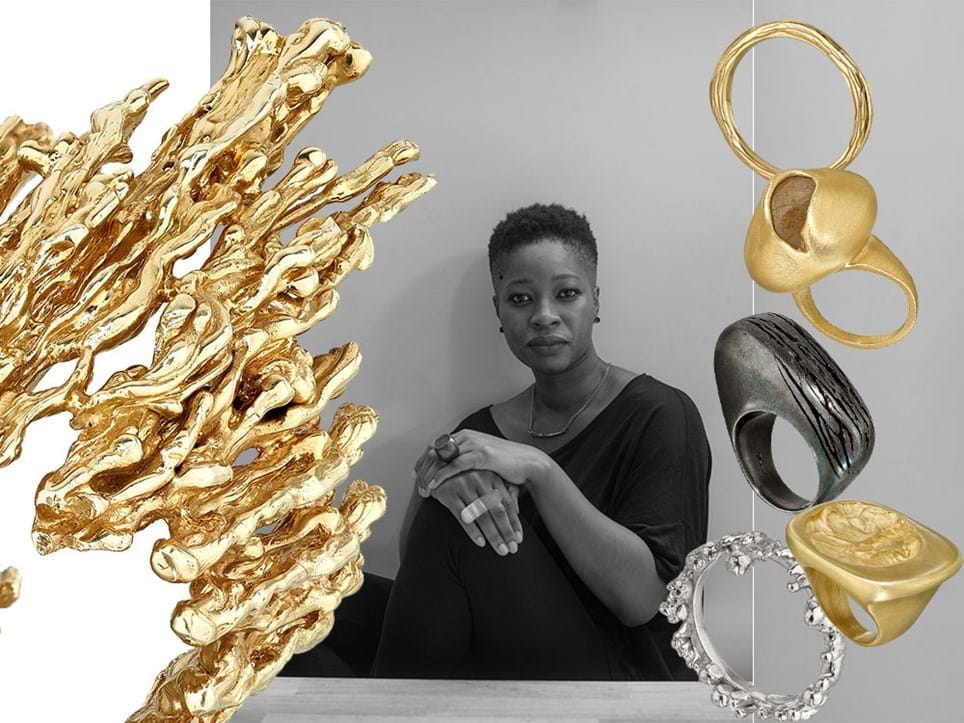Working in the creative industry is never an easy, or financially lucrative task. But for the Ghanian-born, London-based designer, the obsession with creating jewellery started young. “I used to make necklaces out of Job’s tears,” explains Emefa Cole, the jewellery designer who's continually inspired by nature. “They’re seeds that grow on long grass plants that already have holes in them, so all you need to do is pick the seeds and then string them – I used to do that a lot when I was little.” Despite these early memories of creating, training to be a jewellery designer wasn’t her original plan. In 2003, Cole was ready to start a degree in Forensic Science when she walked into a WH Smith and decided to go with her dream of making jewellery. “I picked up a copy of Floodlight magazine, it used to be a course guide for all of the universities and colleges in Britain. I was flicking through it and there was this huge advert for the London GuildHall University and it said ‘silversmith and jewellery design’, and I thought that was interesting. I came home and thought, if I’m going to try that and forget the forensic science idea, perhaps I should do a taster course and see if I’d like it.”
Which, she inevitably did. Fast forward to 2020, and Cole has established herself with her own brand, and two collections to date. Evident in her unpolished approach to jewellery design, she’s inspired by the strong and powerful elements to nature. Her collection, Erosion, consists of chunky bronze rings with a gold-leaf crater or silver earrings in an unusual triangular-prism shape. “I lived in Ghana until the age of 12 and whenever it rained, it was very heavy and tropical, and it would come down and wash the earth away. I’ve always heard stories of people finding gold nuggets because the process of the rain washing away revealed them,” shares Cole. “I remembered thinking it would be such an amazing thing to find... It’s about finding treasure in unsuspecting places.” She replicates this in her jewellery by plating and layering her metals. “I think it’s great because over time it would wear and start to fade and then you’d be able to see the other layer underneath it.”
As well as the natural influences, Cole’s heritage plays a huge part in defining her craft as a designer. “I think because I travelled and moved from totally different continents, so young there’s always that longing for home,” she expresses. “I think I look to the continent of Africa for inspiration because I don’t just think that Ghana is my home.” While many of us where baking banana bread and Marie-Kondo-ing our homes, Cole was in Ghana learning the casting technique by Ashanti goldsmiths, who are a part of one of the most famous kingdoms in West Africa. “If you Google Ashanti, you’ll see images of him completely covered in huge gold pieces. I was very fortunate to be allowed to study with his personal goldsmith, it’s very rare because women often don’t do gold smithing in Ghana and they definitely don’t let anybody and any outsider in to learn with him. I did that for two weeks in Kumasi and then I had to get a flight back.” Despite the pause on learning, covid certainly hasn’t stopped Cole’s desire to learn more about the craft. “I will be going back for a further minimum six week period because there is still so much more to learn. So far, I’ve learnt the foundations, but what was exciting was that I took my own pieces of carved wax with me and we tried it out with their technique, to see if it would work with the wax that I’ve been using. They weren’t perfect, but I think with more trial and error I’ll get them to work. Eventually, the plan is to use the Ashanti, West African wax casting technique on my pieces, which will make each piece so special and unique.”
Despite the obvious differences between jewellery making and her original forensic science route, she’s come to realise how those paths overlap. “I recently found out that there was a lady called a forensic jeweller. She basically helps in crime cases to identify who the jewellery belonged to.” Despite the morbid circumstances in which the jewellery is found, Cole manages to translate this as a possible resting place for her earthly jewellery. “One of the things that I have always been fascinated by is archaeology, and the idea that we are here for a period and then we’re gone. But by making pieces that will hopefully be around for thousands of years after I’m gone, it means that someone could be digging up a ring in a field somewhere and it will be traced to me, because it will have my hallmarks. Although I won’t be around, I’ve sort of left my mark on the world and that is very special.” How can you get more connected to the earth than that?
You can browse Emefa's jewellery here.
More More More!
+ In Conversation with Patcharavipa...
+ In Conversation With Alighieri...
+ Surprise Me!







